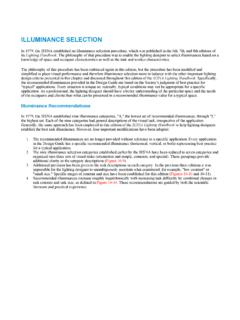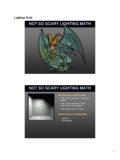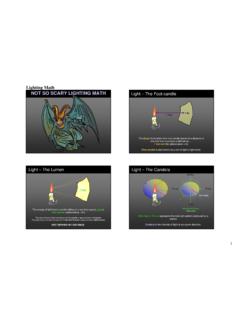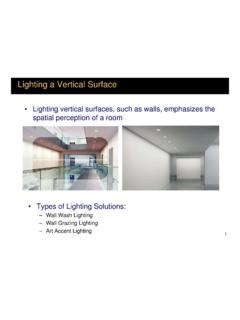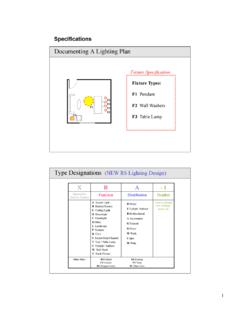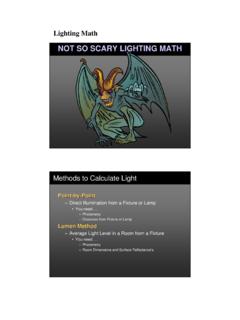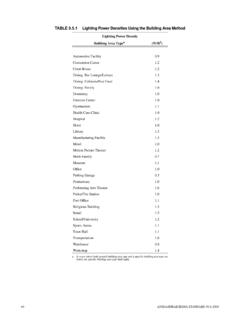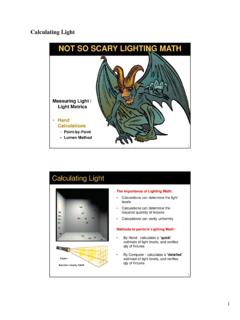Transcription of Design - Light in Architecture and Psychology of …
1 1 Light In Architecture and Psychology of Light1 Designing with LightThe majority of the information that we receive about the world around us comes through our eyes. Light is not only an essential prerequisite, it is the medium by which we are able to see. Through its intensity, the way it is distributed and through its properties, Light creates specific conditions which can influence our perception. Lighting Design is, in fact, the planning of our visual environment. Good lighting Design aims to create perceptual conditions which allow us to work effectively and orient ourselves safely while promoting a feeling of well-being in a particular with Light Light plays a central role in the Design of a visual environment. The Architecture , people and objects are all made visible by thelighting. Light influences our well-being, the aesthetic effect and the mood of a room or area.
2 It is Light that first enables what you see .Our perception of Architecture will be influenced by Light : Light defines zones and boundaries, Light expands and accentuates rooms, Light creates links and delineates one area from and Process The basis for every lighting concept is an analysis of the the tasks the lighting is expected to fulfill, the conditions and special features of a space or work surface. When it comes to qualitativeplanning, it is necessary to gain as much information as possible about the environment to be illuminated, how it is used, who will use it and the style of the Architecture . A quantitativedesign concept can to a large extent follow the standards laid down for a specific task. standards will dictate how much Light is needed, the degree of glare limitation, the source color and color An understanding quality versus quantity Art and Science4 Planning and Process: Schematic Preliminary lighting concepts list the properties that lighting should possess.
3 They may give no exact information about the choice of lamps or fixtures or their arrangement. Further analysis provides illumination guidelines giving information about the individual forms of high Light levels will need high performance fixtures and lamps, etc. The challenge of a qualitative lighting Design is to develop a Design concept that combines the technical and aesthetic requirements of complex guidelines. A concept that delivers the required performance with a equal level of technical expertise and the highest level of artistic clarity will produce the most convincing solution. 2 Light In Architecture and Psychology of Light5 Summary Utilization of Space Psychological Requirements Architecture and AmbiencePlanning and Process: Design Development As the Design phase progresses, decisions are made regarding: the lamps and fixtures to be used the arrangement and installation of the fixtures any required electrical and control devices The decision regarding lamp type can be made at the beginning of a project or left until an advanced planning stage Lighting layouts (the plan) can be determined by the choice of a Light fixture or could be the criteria for fixture selection.
4 Lighting Design process should be seen as a back and forth check in which developed solutions are repeatedly compared to the predetermined goals and requirements. 6 Vision: We See BrightnessThe perception of brightness of the grey field depends on the environment - in bright surroundings, an identical grey appears darker than in dark surroundings. The fact that a medium grey area will appear Light grey if it is bordered in black, or dark grey if it is bordered in white. This can be explained by the fact that the stimuli perceived are processed directly - brightness is perceived as a result of the lightness contrast between the grey area and the immediate surroundings. What we are considering here is a visual impression that is based exclusively on sensory input which is not influenced by any criteria of order linked with our intellectual processing of this information.
5 7 Lighting Effects: Shadows and GradientThe continuous luminance gradient across the surface of the wall is interpreted as a property of the lighting. The wall reflectance factor is assumed to be constant. The grey of the sharply framed picture is interpreted as a material property, although the luminance is identical to the luminance in the corner of the room. Changing luminance levels may arise from the spatial form of the illuminated object; examples of this are the formation of typical shadows on objects such as cubes, cylinders or spheres. 8A non-continuous luminance gradient across a surface may create confusion, miss-information, or the perception of darkness / gloom or is this drama?Lighting Effects: Shadows and Gradient3 Light In Architecture and Psychology of Light9 Lighting Effects: Illumination of 3D ObjectsLight from multiple models a sculpture expresses depth by highlighting some areas while allowing others to fall into shadow different angles render material variations with lesser or greater emphasisKey Light onlyFill Light onlyBack Light onlyCombination Key, Fill, and Back lightIrrespective of size, a three-dimensional artifact must be illuminated from several different directions.
6 10 Light and PerceptionFixed objects produce retinal images ofvarying shapes, sizes and brightness. Due to changes in lighting, distance or perspective, this indicates that mechanisms must exist to identify these objects and their properties and to perceive them as being constant. 11 Psychological Impressions Of ColorWarm colors tend to advanceCool colors tend to recede12 Psychological Impressions Of ColorUsing warm and cool sources for Key and Fill Light not only increases sense of shape and depth of an object, but assist with defining direction of lightCool Light And Warm Shade:Color also can provide information about an object's dimensions and depth. Our visual system assumes the Light comes from above, we rely on our visual experience with nature to explain direction of Light visual experience tells us warm Light comes from the interior illumination, a cooler Light source comes from nature daylight at day, moonlight at night 4 Light In Architecture and Psychology of Light13 Types of LightingDirect14 Types of LightingIndirect15 Forming Functional Zones Large areas that on the whole are evenly illuminated can appear rather monotone if they are not divided up.
7 Room illuminated evenly16 Forming Functional Zonesunlit room5 Light In Architecture and Psychology of Light17 Forming Functional Zones Distinct contrasts between individual zones and their surroundings remove them from their spatial context. room with left wall illuminated (simulate daylight)18 Forming Functional Zonesroom with rear walls only illuminated Light can be used to emphasize individual functional zones in an area, traffic areas, waiting areas, and exhibition areas. 19 Forming Functional Zones Light can be used to emphasize individual functional zones in an area, traffic areas, waiting areas, and exhibition areas. room with objects only illuminated20 Forming Functional Zones Light can be used to emphasize individual functional zones in an area, traffic areas, waiting areas, and exhibition areas. room with stairs only illuminated6 Light In Architecture and Psychology of Light21 Forming Functional Zones Zonal lighting with delineated beams of Light visually separates one area from another.
8 Room with objects and stair illuminated22 Forming Functional Zones Different illuminance levels establish a perceptual hierarchy and direct the viewer's gaze. room with left wall and stair illuminated equally23 Forming Functional Zones Differentiated lighting of functional zones divide up an area and improve orientation. room with rear wall and stair illuminated24 Forming Functional Zones The differentiation of Light colors creates contrasts and emphasizes individual zones. room with left and rear walls illuminated7 Light In Architecture and Psychology of Light25 Forming Functional Zones26 Forming Functional Zones -Exterior27 Forming Functional Zones -Exterior28 Defining Spatial Borders -Horizontal Floor illumination emphasizes objects and pedestrian surfaces. floor lit with downlight fixtures8 Light In Architecture and Psychology of Light29 Defining Spatial Borders -Horizontal Indirect lighting of a ceiling creates diffuse Light in the room with the lighting effect being influenced by the reflectance and color of its uniformly lit with uplight wall fixtures30 Defining Spatial Borders Horizontal31 Defining Spatial Borders Horizontal32 Defining Spatial Borders Horizontal9 Light In Architecture and Psychology of Light33 Defining Spatial Borders -Vertical Vertical spatial borders are emphasized by illuminating wall surfaces.
9 Uniform Light distribution emphasizes the wall as a whole. Bright walls create a high level of diffuse Light in the room. Vertical illumination is used to shape the visual environment. Room surfaces can be differentiated using different levels of illuminance to indicate their importance. Uniform illumination of the surfaces emphasizes them as an architectural feature. walls uniformly lit with wall fixtures34 Defining Spatial Borders -Vertical Vertical spatial borders are emphasized by illuminating wall surfaces. Uniform Light distribution emphasizes the wall as a whole. Bright walls create a high level of diffuse Light in the room. Vertical illumination is used to shape the visual environment. Room surfaces can be differentiated using different levels of illuminance to indicate their importance. Uniform illumination of the surfaces emphasizes them as an architectural feature.
10 35 Defining Spatial Borders -Vertical Grazing Light gives the wall structure by adding patterns of Light . A decreasing level of brightness across a wall is not as effective as uniform wall washing at defining room surfaces. Lighting effects using grazing Light emphasis the surface textures and become the dominant feature. 36 Defining Spatial Borders -Vertical10 Light In Architecture and Psychology of Light37 Defining Spatial Borders -Vertical38 Defining Spatial Borders -Vertical3940 Emphasizing Architectural Features The illumination of architectural details draws attention away from the room as a whole towards individual components. Columns appear as silhouettes in front of an illuminated wall. walls lit with grazing fixtures11 Light In Architecture and Psychology of Light41 Emphasizing Architectural Features Rooms can be given a visual structure by illuminating the architectural features.

